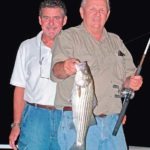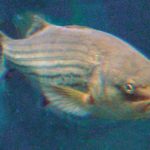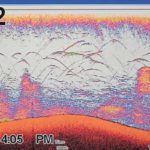
Summer action is hot at night on Lake Murray. Guide Ben Lee explains just how hot.
It was an odd place for a reunion — the former bass pro, the dedicated sponsor, and the newspaper man who often wrote about both of them. What made the scene more unique was that the reunion took place at midnight, and talk was thrown over the shoulders of the attendees as they hauled striped bass from the dark waters of Lake Murray. Discussions of the past may have been about green fish, but at the present it was all about reeling in rocks.
“Ben Lee and Bill Morgan have had a long-lasting friendship dating back to the old Hawg Caller days when Bill owned the company and had Ben and many of South Carolina’s best bass fishermen — Joel Page, Ed Belkin, Ray Sedgwick and the late Carl Maxfield — on his pro staff,” said Dan Kibler, now managing editor of South Carolina Sportsman. “Bill probably enjoys his time on the water even more since he’s retired — and not just fishing for largemouth bass. Getting to fish for stripers with Ben is a real treat.”
As a bass pro for nearly 25 years before retiring to guide for striped bass on Lake Murray, Lee learned that patterning bait was a precursor to catching largemouth bass.
Striper fishing is no different. Once the annual spawn is over in late May, Murray’s ample supply of blueback herring leave the shallows and migrate out to deep water. Lee said his night-time pattern for deep-water striper fishing starts shortly thereafter.
“I’ll start fishing around the mid-lake area in June,” he said. “I’ll start at the area we call The Gap. In this area the water depths range somewhere between 45 and 70 feet deep, and I want to find where the herring have collected back up over deeper water. Find the bait, find the fish.”
As the summer progresses, these baitfish movements dictate where Lee sets up to fish. He’ll follow them from The Gap along the old Saluda River channel as they move over deeper water, into the 100-foot depths. By August, they will have summoned him to water that’s closer to 200 feet — often within casting distance of the dam.
“I want to know there’s bait under the boat, but I also want to know that I’ve got quality bait in my bait tank,” said Lee, who keeps and stores enough bait to fish for a week in his boat house next to his dock, but he offers that there is plenty of quality bait available from retailers all around Lake Murray. It’s what you do with that bait that can make a difference.
“I believe in using a quality bait tank that will aerate and filter the water. You need to have your water circulating in the tank for at least an hour before you add your bait so that the chemicals, mainly salt and bait saver, have time to acclimate. Add ice to keep the water cool, but make sure that if you’re using ice, it’s not made from city water that has chemicals added to remove the oxygen.”
Lee is adamant about having lively bait, right down to the way he puts it on the hook. He uses standard J-hooks when night-fishing, and he foregoes the industry standard practice of nose-hooking his bait.
“I’m left-handed, so I hold the bait in my right hand and hook it from left to right through the back, just in front of the dorsal fin,” he said. “When a striper bites, he takes the bait from the head, and hooking the bait like this puts him in a better position to get the hook — plus the bait has more action. It’s all about the wiggle.”
A grave mistake made by too many night anglers is to think that putting out lights is a guarantee of drawing in fish. Lee has an intricate lighting system arranged on his 31-foot TriToon pontoon boat. A generator that powers nearly a dozen 100-watt bulbs provides both light to fish by and area lighting to anchor bait.
“The key is first finding the bait with your graph, then anchoring on the bait,” he said. “The lights help keep the bait at your location, and the bait will draw the fish. A lot of anglers think they’ll draw the bait and fish to them by putting out lights, and they’ve got it backwards.”
If he has a night with enough wind to hold the boat in position, Lee only has to use a single anchor from the bow to stay in place. One anchor is preferred since his bait presentation is straight down using 12 rods. His tactic is downrod fishing in its classic sense, and he uses the classic gear and setup, all of which is manufactured within 50 miles of Lake Murray — Shakespeare Striper Ugly Stiks paired with medium-heavy baitcasting reels placed in Driftmaster rod holders.
“If there is no wind to hold the boat I’ll have to go to a double-anchor setup,” he said. “It takes a lot of anchor line to anchor in 100 feet of water, but without that second anchor, the boat will drift back over the front anchor, then you have a mess with 12 rods, and it’s a possibility you could drift off the fish.”
Once he’s anchored on bait with lights aglow and a dozen baits dangling in the depths, he’s as prepared as he can get for an evening of controlled chaos. Most times, Lee has his hands full re-baiting lines, helping watch for bites, and unhooking and measuring fish. He also has a secret weapon — his wife Ann is one of the best “net men” around.
“Another plus for Reel Adventures Guide Service,” grinned Lee. “I’ve got the best looking first mate on Lake Murray!”










Be the first to comment